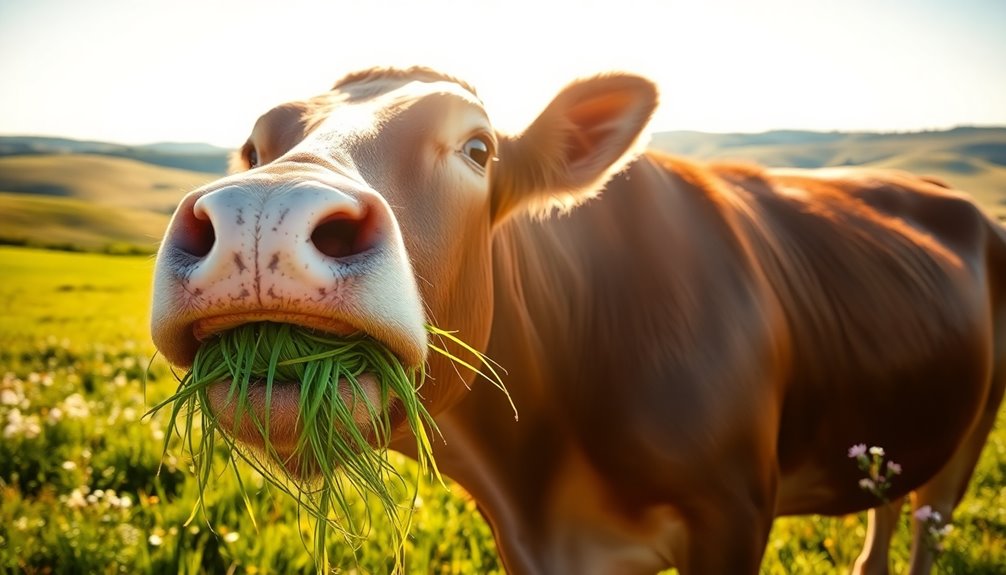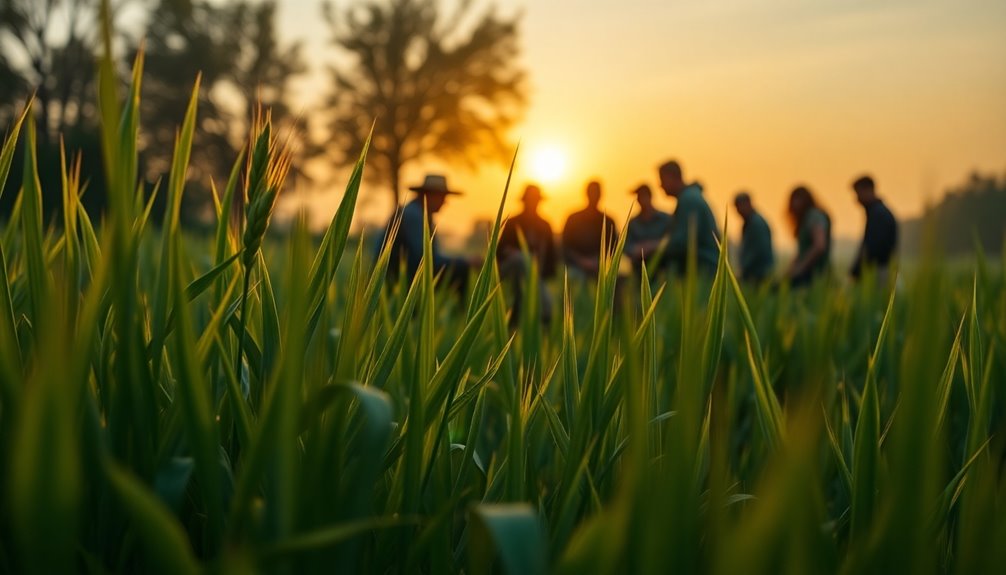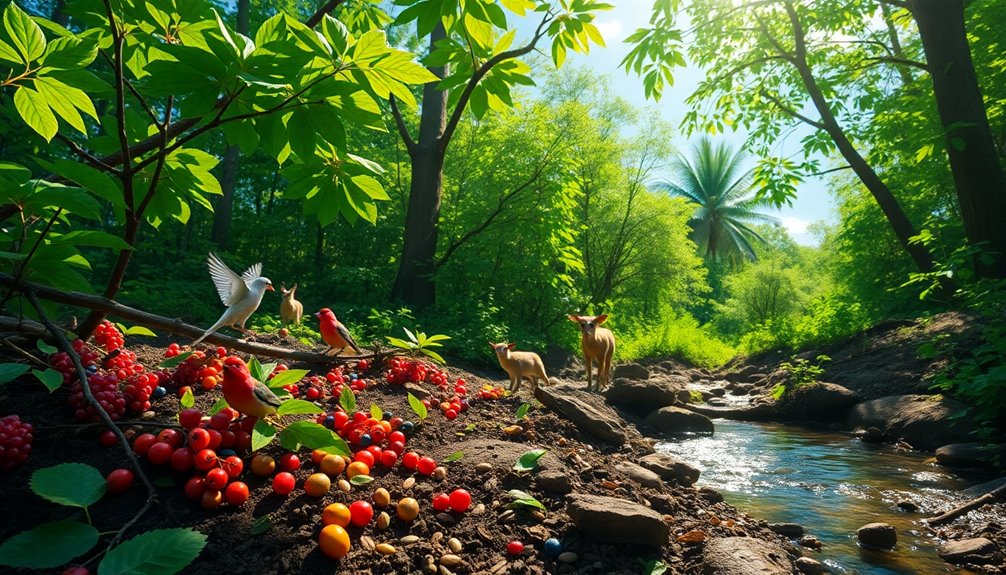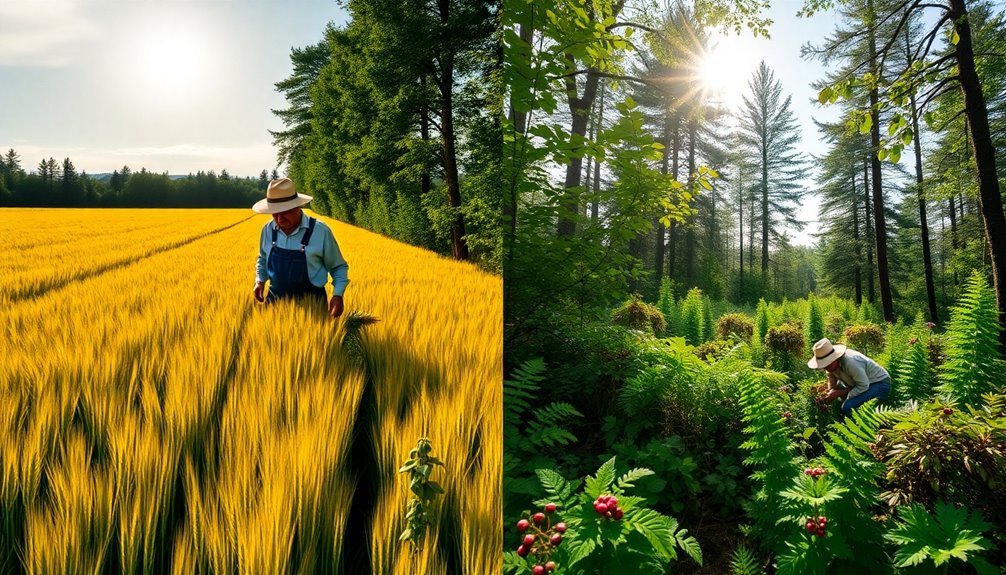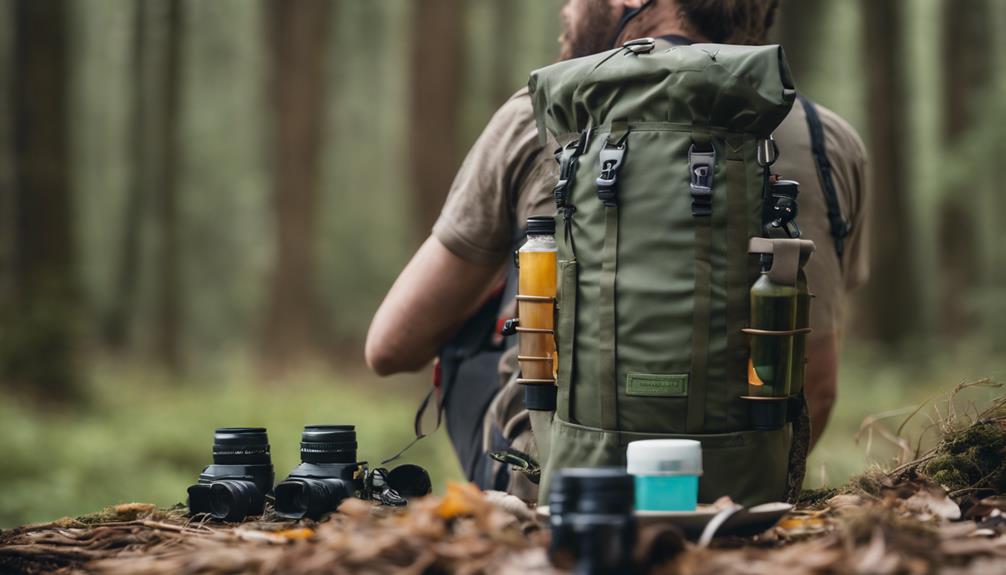Foraging can truly transform how you see nature. First, foraging for edible plants like dandelions and chickweed not only adds flavor to your meals but teaches you about local biodiversity. Next, mushroom foraging opens a world of unique fungi, pushing you to learn their critical characteristics to avoid toxic varieties. Finally, participating in community foraging events fosters shared experiences and nurtures deeper connections with both people and the environment. As you explore these foraging types, you'll gain insight into sustainable practices and the harmony between culinary adventures and ecological stewardship. There's so much more to discover!
Key Takeaways
- Edible plants foraging reveals nutrient-rich wild foods, enhancing culinary experiences and fostering a connection to local ecosystems.
- Mushroom foraging teaches proper identification, encouraging appreciation for fungi's ecological roles and supporting sustainable practices.
- Community foraging promotes teamwork and social bonds, deepening awareness of local biodiversity and stewardship of natural resources.
- Exploring culinary uses of foraged ingredients can introduce unique flavors and connect individuals to traditional cooking methods.
- Engaging in foraging activities fosters ecological awareness, encouraging respect for nature and understanding the importance of conservation.
Foraging for Edible Plants
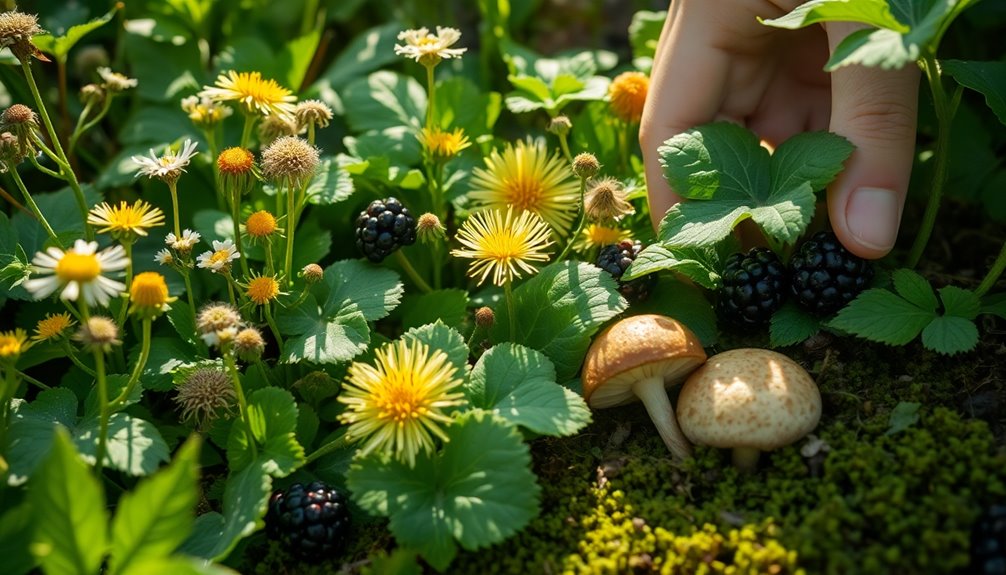
Foraging for edible plants can be a rewarding adventure, allowing you to discover nature's hidden culinary treasures. As you explore your surroundings, you'll encounter a variety of edible wild plants like dandelions, chickweed, and plantain. These nutrient-rich species are often abundant in various environments, providing you with fresh wild food options right at your fingertips. Additionally, understanding seasonal growth patterns can significantly enhance your foraging success. In regions like Minnesota and Michigan, foragers can find a rich diversity of edible plants throughout the year. Moreover, many of these plants can be utilized in creating acorn bread, introducing unique flavors to your meals. For example, foragers can often find basket weaving materials to craft containers for gathering their finds.
However, before you start harvesting, it's vital to confirm you can accurately identify these plants. Some edible species have toxic look-alikes, so relying on field guides and seeking advice from experienced foragers is essential.
Sustainable foraging practices recommend limiting your collection to no more than 10% of any plant population. This approach helps prevent overharvesting and guarantees that these valuable resources remain available for future foragers.
Many edible plants, such as wild mint and staghorn sumac, can enhance your culinary experiences, allowing you to create unique dishes and beverages. Additionally, foragers should consider the nutritional balance of the plants they collect, ensuring a diverse and healthy diet from their wild food sources.
Engaging in foraging not only grants you access to organic food but also fosters a deeper connection to local ecosystems. You'll appreciate the diverse roles of native plant species while discovering the medicinal value they can offer.
Immerse yourself in this adventure and embrace the world of edible wild plants!
Mushroom Foraging Adventures
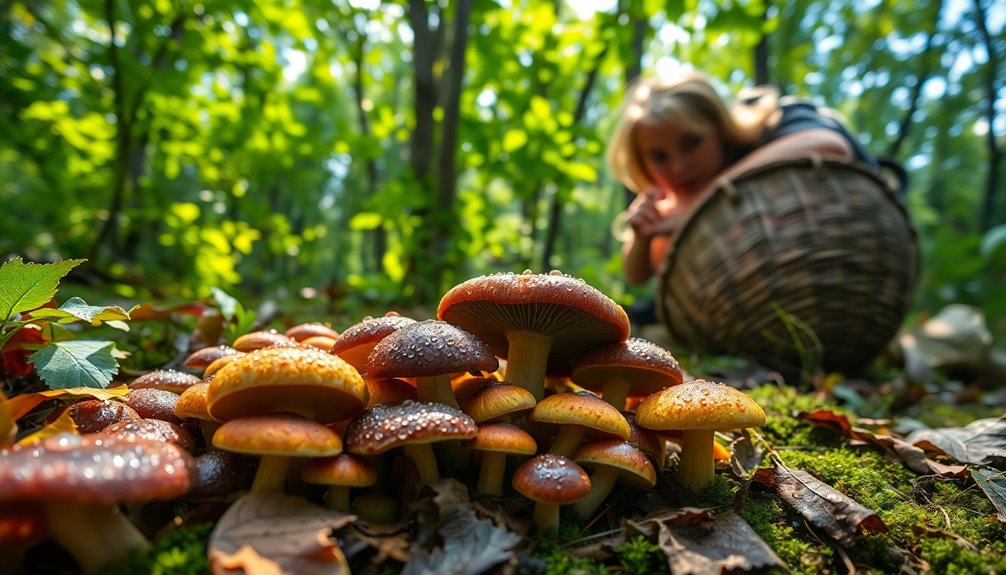
When you venture into the world of mushroom foraging, you'll uncover a rich variety of edible fungi like chanterelles, morels, and porcini, each boasting distinct flavors that can elevate your culinary creations. Engaging in mushroom foraging not only rewards you with delicious finds but also deepens your appreciation for local ecosystems and the connections between species.
To enjoy a successful foraging adventure, proper identification is essential. Many edible species have toxic look-alikes, so it's wise to invest in a reliable foraging guide or consult local experts. Beginners should consider joining foraging groups, where experienced foragers can share their knowledge and insights.
Timing plays an important role in mushroom foraging. The best conditions often follow periods of rain, especially during spring and fall, when mushrooms flourish. While some mushrooms, like puffballs, are easier to identify due to their size and uniform appearance, always double-check your findings.
With patience and practice, you'll navigate the enchanting world of mushrooms, transforming your culinary endeavors while fostering a deeper respect for nature's intricate web.
Community and Collaborative Foraging
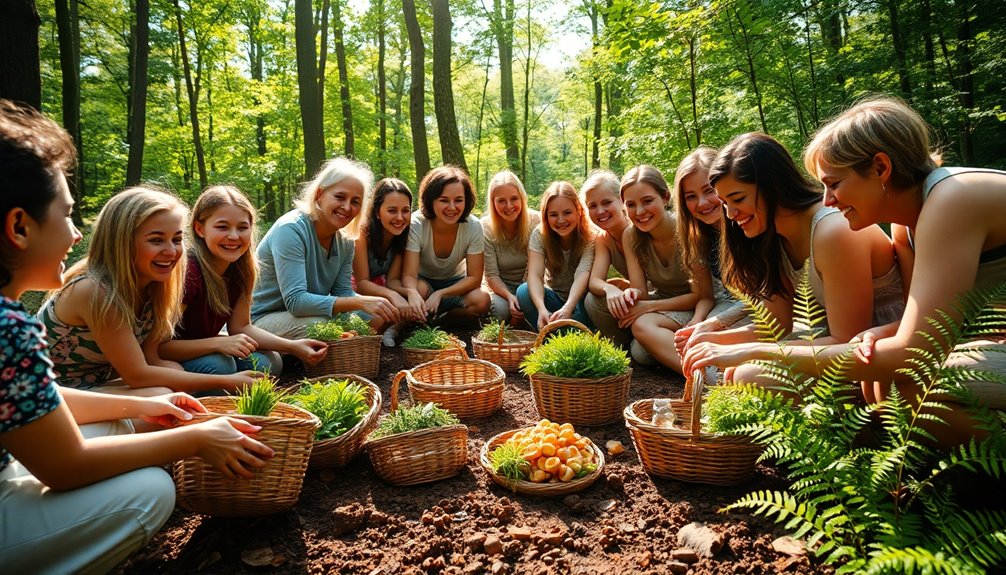
Exploring the world of mushrooms can be an exhilarating solo adventure, but there's something uniquely rewarding about community and collaborative foraging. Engaging in community foraging fosters social bonds through shared experiences and teamwork, allowing you to learn from others while exploring local ecosystems together.
Participating in organized events like group workshops or guided walks enhances your knowledge of wild plants and proper foraging techniques. These structured opportunities not only promote camaraderie but also encourage sustainable practices and responsible harvesting, ensuring the health of wild plant populations for future generations. Additionally, online communities can further enhance your foraging journey by providing support and shared experiences among fellow foragers.
Here's a quick overview of benefits from community and collaborative foraging:
| Benefit | Description | Example Event |
|---|---|---|
| Social Bonds | Build connections through shared experiences | Bilberry picking outing |
| Knowledge Sharing | Learn from experienced foragers | Foraging workshops |
| Sustainable Practices | Promote responsible harvesting | Environmental clean-up |
| Stewardship Awareness | Encourage caring for local ecosystems | Community foraging events |
Frequently Asked Questions
What Are the Different Types of Foraging?
When you explore foraging, you'll discover several types that can enrich your experience.
Wild edibles, like dandelions and morels, offer unique flavors and nutrition. You might also seek out medicinal plants, such as echinacea, for natural remedies.
Nuts and seeds, like acorns, provide healthy fats. If you're near the coast, sea foraging for edible seaweed can be rewarding.
Ultimately, harvesting invasive species helps control their spread while giving you sustainable food options.
What Is Nature Foraging?
Nature foraging is the practice of searching for and gathering wild edible plants, mushrooms, and other natural food sources from your local environment.
As you explore the woods or fields, you'll discover a bounty of nutrient-rich, flavorful options that can enhance your diet.
This activity not only deepens your connection to nature but also promotes sustainability by teaching you to harvest responsibly, ensuring the health of ecosystems for future generations.
What Is the Golden Rule of Foraging?
The Golden Rule of Foraging is simple: take only what you need and leave enough for the ecosystem to thrive.
It suggests you shouldn't harvest more than 10% of any plant population. By focusing on abundant species and avoiding rare ones, you help preserve biodiversity.
Always consider the health of the plant and its surroundings before harvesting. This mindset fosters a respectful relationship with nature, promoting sustainability and ecological balance.
How Does Foraging Help the Environment?
Foraging helps the environment in several ways. When you harvest only abundant species, you support local ecosystems and biodiversity.
Engaging with native plants deepens your understanding of their ecological roles. By thoughtfully foraging, you can assist in removing invasive species that threaten native flora.
Plus, your observations can contribute to habitat restoration efforts, fostering community engagement and collaboration that protect vulnerable species and promote ecological stewardship.
Conclusion
In the dance of nature, foraging reveals hidden treasures that spark joy and connection. As you wander through vibrant forests, each edible plant and mushroom becomes a whisper from the earth, inviting you to savor its story. Embrace the spirit of community foraging, where shared laughter and discoveries forge bonds as strong as the roots beneath your feet. When you immerse yourself in this wild journey, you'll find not just food, but a deeper appreciation for the beauty surrounding you.


